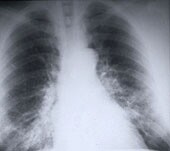Vemurafenib active in NSCLC, Erdheim-Chester disease, Langerhans’-cell histiocytosis
THURSDAY, Aug. 20, 2015 (HealthDay News) — For some, but not all, nonmelanoma cancers, BRAF V600 is a targetable oncogene, with activity seen in non-small-cell lung cancer and Erdheim-Chester disease and Langerhans’-cell histiocytosis, according to a study published in the Aug. 19 issue of the New England Journal of Medicine.
David M. Hyman, M.D., from the Memorial Sloan Kettering Cancer Center in New York City, and colleagues conducted a histology-independent phase 2 study of vemurafenib in 122 patients with BRAF V600 mutation-positive nonmelanoma cancers. Patients were enrolled in six prespecified cancer cohorts, and patients with all other tumor types were enrolled in the seventh cohort.
The researchers found that the response rate was 42 percent and median progression-free survival was 7.3 months in patients with non-small-cell lung cancer. The response rate was 43 percent and median treatment duration 5.9 months, with no disease progression during treatment, in the cohort with Erdheim-Chester disease or Langerhans’-cell histiocytosis. Among patients with pleomorphic xanthoastrocytoma, anaplastic thyroid cancer, cholangiocarcinoma, salivary-duct cancer, ovarian cancer, and clear-cell sarcoma, as well as among patients with colorectal cancer who received vemurafenib and cetuximab, there were anecdotal responses. Safety for vemurafenib was comparable to that reported in previous melanoma studies.
“BRAF V600 appears to be a targetable oncogene in some, but not all, nonmelanoma cancers,” the authors write. “The histologic context is an important determinant of response in BRAF V600-mutated cancers.”
The study was funded by F. Hoffmann-La Roche/Genentech.
Full Text (subscription or payment may be required)
Copyright © 2015 HealthDay. All rights reserved.








